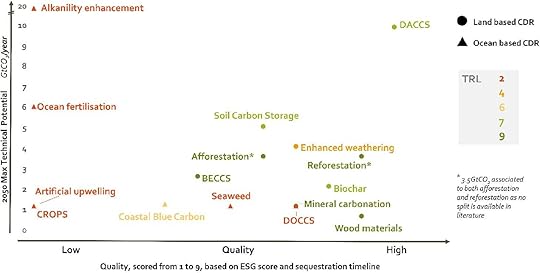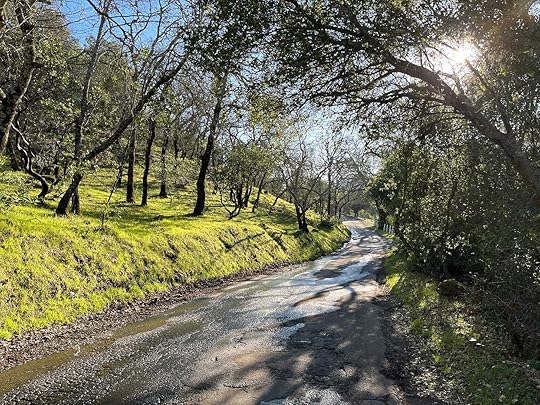Work Less
Welcome to We Can Fix It, where we tackle the climate crisis with facts, feelings, and action. Written by me, climate scientist Kim Nicholas.
Hi friends, I hope you had peaceful holidays. For me it was a tough end to a tough year. My husband Simon’s dad died unexpectedly two weeks before Christmas. I am grateful for the time we got to spend with family and friends, and now glad to be back home in Sweden. <3
 With Simon and his family in Banff National Park for Christmas. Photo: KN
With Simon and his family in Banff National Park for Christmas. Photo: KNOn my mind lately: carbon removal done right, turning worry to compassion, and working less.
Facts: Carbon removal done rightI've long cautioned carbon removal is a limited and risky climate tool. It’s often used today to justify continued pollution and delay the necessary phaseout of fossil fuels. Current offsetting schemes often avoid necessary real reductions. The priority must remain stopping emissions at their source.
So why did I coauthor this new paper on carbon removal?To be clear, at least 90% of our efforts, funding, and attention must be on eliminating emissions at their source. As we wrote in our paper led by Jan Mertens, “Carbon dioxide removal technologies should be considered once efforts have already achieved a >90% reduction in emissions.”
However, carbon removal will likely play *some* role to stabilize the climate. To stop warming, humans have to stop adding CO2 to the atmosphere. To achieve this, any remaining hardest-to-cut, last <10% emissions will have to be removed.
And we’ll need to take carbon out of the atmosphere if we want to return to a safer climate, from today’s already-dangerous 425 parts per million CO2 and rising, to reach a goal like 350 ppm.
This means targeted carbon removal must be done right.
Assessing risks and benefits of carbon removalIn our new study, we evaluated 16 carbon dioxide removal strategies, from natural solutions like planting forests to building machines to suck carbon out of the air. While many studies focus on technical effectiveness, neglecting risks and social implications, we assessed these strategies on four dimensions:
1. Environmental, Social, and Governance (ESG) scoreThe author team rated each strategy on:
Environmental benefits (e.g., improved soil quality, biodiversity protection)
Environmental integrity (e.g., risk of ecosystem disturbance, biodiversity risk)
Social acceptance (e.g., greenwashing risks, fairness in project siting)
Governance preparedness (alignment with existing policies and regulations)
2. Time scale of carbon storageBecause carbon is forever, any useful attempt to neutralize fossil carbon has to last essentially forever.
We categorized carbon removal strategies into three durability levels:
Short-term (<100 years): Forests, soils and ocean ecosystems. These can help neutralize short-lived methane and land-use emissions, but don't provide lasting storage for fossil fuel emissions.
Medium-term (100-1,000 years): Biochar and some ocean-based technologies.
Long-term (>1,000 years): Geological, “permanent” carbon dioxide removal and storage, like from direct air carbon capture and storage (DACCS). Long-term strategies are the only ones that credibly neutralize fossil CO2 emissions. Less durable storage still leads to warming, as this recent paper showed; see ’s excellent post from Climate Brink.
We combined ESG and durability into a Quality score (see X-axis below).
3. Technical potentialHow much CO2 (gigatonnes per year) could each approach remove by 2050?
Our estimates are based on existing scientific literature.
Shown on the Y-axis below.
4. Technology readiness levels (TRL)We assigned a score from 1 to 9 for each technology’s maturity:
1: Basic principles observed.
9: Actual system proven in operation today.
Shown by colors from red (low) to high (green) in the graph below.
Rating carbon removal qualityOur findings highlight direct air capture (DACCS) as one of the highest-quality carbon removal options, with high ESG ratings, long-term durability, and fairly high technical potential. Other promising but shorter-term strategies include reforestation, building with wood materials, biochar, and soil carbon storage. In contrast, ocean-based approaches were rated of lower quality due to high uncertainties and risks to ocean ecosystems.
 Rating 16 strategies for carbon removal based on quality (combining ESG factors and storage durability), effectiveness (potential gigatons of CO2), and technical readiness level (TRL). Strategies to the upper right corner are the best. Darker green strategies are most technically ready. Source: Mertens et al., 2024. Feelings: Turn Worry to Compassion
Rating 16 strategies for carbon removal based on quality (combining ESG factors and storage durability), effectiveness (potential gigatons of CO2), and technical readiness level (TRL). Strategies to the upper right corner are the best. Darker green strategies are most technically ready. Source: Mertens et al., 2024. Feelings: Turn Worry to CompassionA few weeks ago, I was on a beautiful walk but stuck in a loop of worry— rehashing an unhelpful conversation with one of my dad’s doctors. I suddenly realized I was missing out on the sunlight and birdsong around me, trapped in thoughts that weren’t useful.
That’s when two ideas from 10% Happier by Dan Harris popped into my head.
1. Ask “Is this useful?”Harris suggests this question to distinguish between productive thinking, planning, and problem-solving, vs. repetitive, draining worry. My ruminations were not helping. I’d already helped take the next steps needed for my dad’s care. There was nothing more I could do in that moment.
2. Wish people wellI realized my un-useful worry was rooted in something important, namely my love and care for my dad. Instead of spiraling in my worry, I directed that energy towards another practice from 10% Happier (which Dan Harris classified as “Things I Will Definitely Hate” the first time he tried it).
Picture someone in your mind and silently wish them well:
May you be happy.
May you be safe.
May you be healthy.
May you live with ease.
Thinking these positive thoughts for my dad felt SO much better than taking one more run down the well-worn ski tracks of what-ifs in my mind.
Encouraged, I followed Dan’s advice to think of other people and send them the same well-wishes.
First I thought of “a neutral person, someone you see regularly, but tend to overlook. Your barista, a janitor in your building, a neighbor who doesn’t provoke much of an emotional charge,” as Harris wrote.
It was easy for me to generate good vibes for the smiley desk clerk at the gym whose name I don’t know.
Then, a bigger challenge: a difficult person. As I brought to mind people I struggle with and wished them well, I realized how far they were from happy, healthy, and living with ease. This made me feel more compassion for what they were going through, instead of focusing on my own annoyance.
Why This WorksThe well-wishing practice is a form of loving-kindness meditation (metta) from Buddhism. I like what Dan Harris writes about it:
“This practice can seem forced and treacly, but the research suggests it can have significant physiological, psychological, and even behavior benefits. The upshot is radical: just as happiness is a skill, so is love.”
Next time you find yourself stuck in a loop of worry, try asking, “Is this useful?” If not, instead of spinning in circles, direct that energy to compassion for someone in the worrying situation - including yourself.
 The view I was missing out on stuck in a loop of unhelpful worry. I appreciated it a lot more after I turned that worry towards compassion.Action: Work Less Rethinking Time
The view I was missing out on stuck in a loop of unhelpful worry. I appreciated it a lot more after I turned that worry towards compassion.Action: Work Less Rethinking TimeIn my beloved Politics & Philosophy book club, we just read “How Much Is Enough? Money and the Good Life.” It sparked a discussion about working less.
My relationship with time is changing. I used to focus on optimizing time, squeezing maximum productivity out of every minute. But that approach started to feel relentless, even joyless.
Now, I see time as something I experience, not just spend. I want to enjoy that experience (namely, the moments that add up to being my actual life!).
There’s a lot I enjoy and find meaningful in my work — helping students, contributing to climate solutions. But there’s also a lot outside of work that matters. Increasingly, time feels more precious to me than money.
The Case for Working LessSeveral of my friends have already chosen to work 80% time. Their motivations vary: health, family, volunteering, hobbies. They all love it.
And there are substantial climate benefits to working less:
A systematic review led by Miklós Antal found consistent evidence that reducing paid work time reduced greenhouse gas emissions.
Martin Pullinger’s research found policies that reduced work hours 20% or enabled 3 month career breaks would reduce national emissions by 3-4.5%.
A Swedish study found working 1% less led to an 0.8% drop in greenhouse gas emissions (higher reductions for wealthier households). They recommended gradual reduction to a 30 hour work week.
The main reason working less helps the climate is that earning less money lowers consumption (rather than ). Higher incomes drive higher-carbon lifestyles.
Of course, not everyone can afford to work less. But those of us in the top 10% globally are the ones who need to shrink our footprints anyway! Low-income folks emit very little already.
An inspiring auto-replyMy friend Diana Ivanova, a lecturer at Leeds University, has the best email auto-reply. She generously gave me permission to share it with you here (I’ve modified and embedded the links):
How to work less
Hi there,
I am working four days a week and will get back to you next week. The reason for that is that working less has various social and environmental benefits* that are worth exploring more.
I definitely recommend you try it out if you have the possibility!
*Some references on how working less may help:
Reduce greenhouse gas emissions and energy use
Reduce income inequality and gender imbalances in the distribution of paid work, and sustain employment
Improve health and reduce overconsumption of food [by replacing work with sleep!]
Contribute to personal, family and community well-being and decrease the importance of materialistic values
Best wishes,
Diana
Not all reduced work schedules have the same climate benefits. A UK study found:
✅ Best option: Three-day weekends—closing offices on Fridays saved the most emissions.
✅ Good options: Free Wednesdays or coordinated work reductions (e.g., hot desking) also helped reduce emissions.
❌ Worst options: Shorter workdays (same commuting + offices stay open, same energy use) and increased paid vacation time (more climate-intensive air travel).
The more people work less, the greater the climate benefits, especially if employers coordinate their resources efficiently.
Maybe your next water cooler chat with colleagues (or your boss!) should be about working less? I’m going to give it a try!
P.S. Recommended reading that influenced my thinking about valuing time: Four Thousand Weeks, Your Money or Your Life, Momo, Die with Zero.
Thanks for reading! Please share this post with a friend to spread climate action.
Parting Tidbits Upcoming talksI’ll join the wonderful Maria Wolrath Söderberg and Nina Wormbs at Palladium in Malmö on February 11 at 19h for Omställningsont: Bråkshow om att vara människa i klimatkrisens tid (in Swedish). Tickets here.
Recent newsI talked with the BBC about the lowest carbon alcohol.
Book Recommendation10% Happier, by Dan Harris. A refreshingly snarky, honest page-turner that doesn’t take itself too seriously. Harris is quite convincing in his claim that meditation can make you 10% happier. The book doesn’t directly tackle climate, but I found many of the lessons incredibly relevant (like striving for wisely ambitious goals, without being too attached to outcomes out of your control).
xo,
Kim



